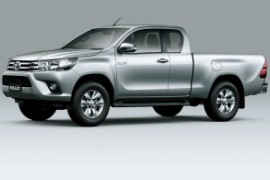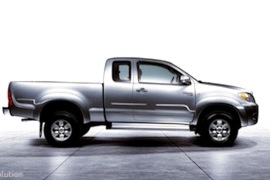TOYOTA Hilux Extra Cab Models/Series Timeline, Specifications & Photos
First production year: 2011
Engines: Diesel
Body style: Truck
The HiLux was one of the most appreciated pickup-trucks in the world for more than half of the century. In 2015, Toyota introduced the eighth generation of the light-utility off-road vehicle.
The recipe for a pickup-truck was quite simple: a bed to load, a cabin to host the driver and its passengers, and an engine in the front. To make it better in off-road conditions, a transfer box and a low range gear completed the main ingredients. The HiLux ticked all the boxes and was offered with a few cab choices.
The HiLux was the best selling pickup-truck in Australia for more than a decade and the 2015 model was brought to keep that sales figures up. It was offered as a single-cab, Extra Cab, and Full-size Cab with four conventional doors. The front end design receives new headlights and a lifted bumper in the front, with two horizontal slats on the grille. The short cabin provided extra room for the bed, where longer items could have been loaded.
The Extra Cab provided a pair of jump-seats in the back, and a pair of half-size suicide doors. But don't expect some comfort for those two places. The extra space in the cabin was a relief for tall drivers, who could tilt their seats backward. The dashboard offered an SUV-like design, with better materials and an option for a 7” infotainment system. It didn't have that basic look of the older models.
One of the reasons why the HiLux was so successful was its reliability and its ruggedness. For the eighth generation if featured a new ladder chassis, stronger than before. For the 2015 model, the HiLux received a new range of engines, with either a 2.4-liter or a 2.8-liter turbodiesel unit. The older 3.0D4-D was retired.
Toyota introduced the seventh generation of the Hilux in 2004 and refreshed it in 2008, but by 2011, it already needed another upgrade, which the Japanese automaker introduced in July.
The world financial crisis was still hurting the sales of all car manufacturers, and Toyota wasn’t spared. However, it could still have a few aces up its sleeves to improve its product lineup without spending too much, and refreshing a well-known product from its lineup was one of the winning strategies. As a result, in July 2011, the Japanese car manufacturer introduced the second facelift for the seventh generation of the Hilux and made it available in three shapes: Single Cab, Extra Cab, and Double Cab. The Extra Cab was the balanced version, which traded some cabin space for more extra loading space while it could still accommodate four people inside.
The Japanese automaker already knew how to create a successful facelift and applied all its knowledge to the 2011 Toyota Hilux Extra Cab. The entire front area was new, from the bumper to the A-pillars. It featured restyled headlights with clear lenses and a more angular shape. Between them, the three-slat grille supported the carmaker’s badge at its top, below a chromed horizontal slat. Lower, on the bumper, the refreshed Hilux featured a redesigned center air intake with a reversed trapezoidal shape and flanked by a set of scoops with available fog lamps.
From its profile up to the B-pillars, the 2011 Toyota Hilux Extended Cab looked more like an SUV than a pickup. Its shaved corners and flared wheel arches gave a muscular appearance to the vehicle. Toyota offered the car a choice of steel or alloy wheels ranging between 15” and 17-inch. Furthermore, the SR and the SR+ grades featured turn signals integrated into the door mirror caps. There was also an option for side steps, which was useful, especially for versions fitted with 4x4 systems. The bed was identical in the back to the one fitted on the 2008 model year. However, the clear taillights were new, and so was the third brake light integrated into the upper side of the tailgate.
Inside, the 2011 Toyota Hilux Extra Cab had something for everyone. The DLX grade, which was the workhorse of the family, had cloth seats and a basic radio integrated into the center stack. Upper grades were available with leather upholstery and even an infotainment system with sat-nav and rear-view camera. In addition, the perceived quality of the materials was increased, and the dashboard was utterly new. It had more horizontal lines, creating the image of a broader cabin. Inside the binocular-styled instrument cluster, the automaker installed a speedometer in the middle, flanked by the tachometer on the left and the fuel and temperature gauges on the right. In the back, the tight space was useful only in an emergency since the jump seats couldn’t provide too much comfort. Legroom was also a problem but considered acceptable for short jaunts.
Under the hood, Toyota installed a choice of two turbodiesel engines: a 2.5-liter or a 3.0-liter unit. Both were paired as standard with a five-speed manual, while a five-speed automatic was on the options list for the latter. Another improvement made by the automaker was the introduction of the sturdy 4WD chassis across the range, even on vehicles fitted with a rear-wheel drive system only. The 3.0-liter engine version was offered only with traction in all corners and a two-speed transfer box.

